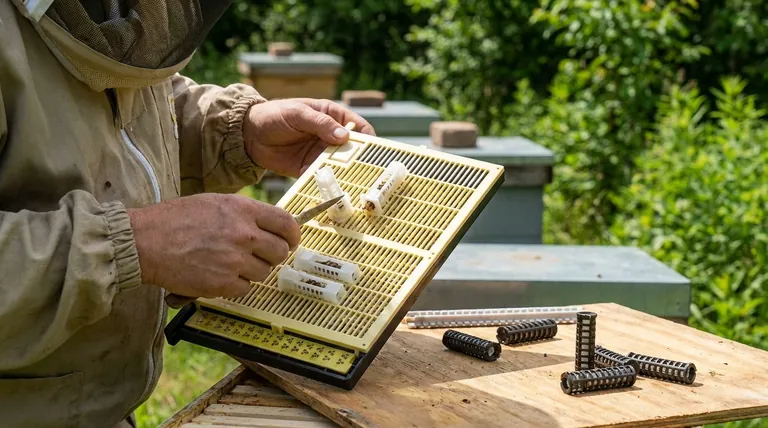When managing your grafting efforts, surplus queens are a valuable resource, not a problem. These extra queens can be used immediately to create queenless splits, to requeen underperforming colonies, or they can be temporarily "banked" in a holding colony for future needs. Proper timing and handling are essential to ensure none of these valuable assets are wasted.
The challenge isn't having too many queens; it's failing to have a plan for them before they emerge. Your goal should be to treat every queen cell as a strategic asset for apiary expansion, genetic improvement, or insurance against future queen loss.

The First Principle: Control the Emergence
The first virgin queen to emerge will immediately seek out and destroy all other queen cells in the colony. To prevent this loss, you must intervene just before they hatch.
### The Critical 24-Hour Window
Queen cells grafted from young larvae will typically emerge around day 15 or 16 after the egg was laid. Your window for action is on day 14. You must protect the cells before the first queen hatches.
### Caging the Queen Cells
The most effective method is to place each mature queen cell into a protective cage, such as a round queen cage or hair roller cage. The cage allows the emerged virgin queen to move and be fed by worker bees but prevents her from attacking the other cells. This simple action is the foundation of managing your surplus.
Core Strategies for Using Surplus Queens
Once your cells are safely caged, you have several powerful options. Your choice will depend on your apiary goals for the season.
### Option 1: Create New Colonies (Nucs & Splits)
This is the most common use for extra queens. A surplus queen is the perfect starting point for a new nucleus colony (nuc) or a larger split.
Simply create a queenless split with several frames of brood, pollen, and honey, and add the caged queen. The bees will readily accept and care for her, and she will be released to begin her mating flights and start laying.
### Option 2: Requeen Existing Colonies
Surplus queens offer an excellent opportunity to improve the genetics of your apiary. You can replace queens in colonies that are aggressive, unproductive, or show poor mite resistance.
To do this, you must first find and remove the old queen. After a period of queenlessness (typically 24 hours), you can introduce the new, caged virgin queen.
### Option 3: "Bank" Queens for Future Use
Banking allows you to hold queens for a short period, giving you flexibility. A queen bank is a strong, queenless (or queenright but separated by an excluder) colony with a high population of nurse bees.
You can place multiple caged virgin queens in this colony, and the nurse bees will care for all of them. This gives you time to prepare nucs or wait for the ideal time to requeen another hive.
Understanding the Trade-offs
While powerful, using virgin queens from your grafting efforts involves risks that must be managed.
### Virgin Queens Are Not Mated
The queens that emerge are virgins. They still need to embark on one or more mating flights. This is a period of high risk due to weather, predation, or simply failing to return to the hive. There is no guarantee every virgin queen will become a successfully mated, laying queen.
### Introduction Is Not Guaranteed
While caging improves acceptance rates, a colony can still reject and kill a new queen upon release. This is especially true when introducing a virgin queen into a very strong, established colony that has been queenright for a long time.
### Banking Is a Short-Term Solution
A queen bank is not a long-term storage facility. While it can safely hold queens for one to two weeks, keeping them banked for too long can diminish their vitality and future laying performance. It is a temporary holding pattern, not a permanent one.
Making the Right Choice for Your Goal
Your best course of action depends entirely on your primary goal for the season.
- If your primary focus is expansion: Prioritize using your surplus queens to create as many nucs and splits as your apiary resources allow.
- If your primary focus is genetic improvement: Use the extra queens to systematically requeen colonies with undesirable traits like poor temperaments or low productivity.
- If your primary focus is flexibility and insurance: Establish a queen bank to hold your surplus queens, giving you time to assess colony needs and respond to unexpected queen loss.
By treating every extra queen as an opportunity, you transform a potential surplus into a strategic asset for your entire beekeeping operation.
Summary Table:
| Strategy | Best For | Key Action |
|---|---|---|
| Create Nucs/Splits | Apiary Expansion | Add caged queen to a queenless split with brood and food. |
| Requeen Colonies | Genetic Improvement | Remove old queen, introduce new caged virgin queen after 24 hours. |
| Bank Queens | Flexibility & Insurance | Hold multiple caged queens in a strong, queenless holding colony. |
Maximize the potential of every queen cell with professional-grade equipment from HONESTBEE.
Whether you're a commercial apiary focused on expansion or a distributor supplying the beekeeping industry, having the right tools is crucial for successfully managing surplus queens. From protective queen cages for safe handling to equipment for building strong nucs, HONESTBEE supplies the durable, wholesale-focused beekeeping supplies you need to turn a grafting surplus into a strategic advantage.
Contact our team today to discuss your equipment needs and elevate your queen management program.
Visual Guide

Related Products
- No Grafting Queen Rearing Kit: System for Royal Jelly Production and Queen Rearing
- Brown Nicot Queen Cell Cups for Breeding Queen Bees Beekeeping
- Black 2 Pack Beekeeper Queen Grafting Tool for Bee Queen Larva Transferring Needle
- Plastic Chinese Queen Grafting Tool for Bee Queen Rearing
- Double Head Beekeeping Grafting Tools for Beekeepers
People Also Ask
- What is the timeline for queen breeding? A 28-Day Guide from Egg to Laying Queen
- What are the stages involved in queen raising? A Guide to Controlled, High-Quality Queen Production
- What are the signs that indicate a colony needs requeening? Protect Your Hive's Health and Productivity
- What should be done once eggs are present in the comb box? A Guide to Maximizing Queen Rearing Success
- What are the developmental periods for different bee castes? Master the 16, 21, and 24-Day Timelines for Hive Success



















